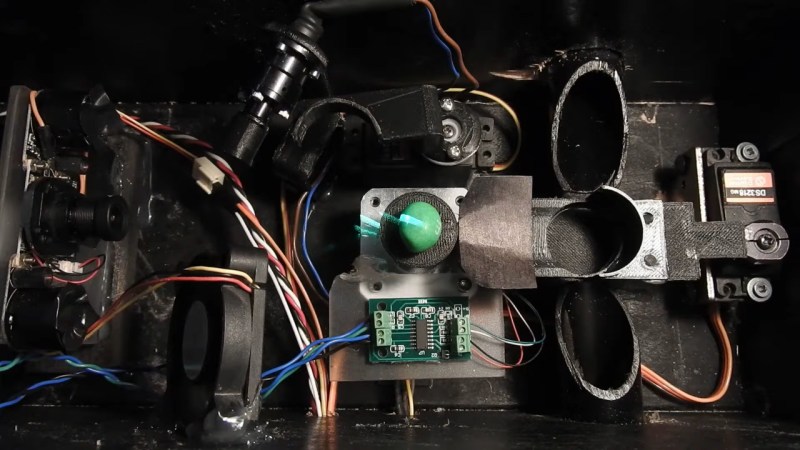Candy-sorting robots are in plentiful supplies on these pages, and with good reason — they’re a great test of the complete suite of hacker tools, from electronics to machine vision to mechatronics. So we see lots of sorters for Skittles, jelly beans, and occasionally even Reese’s Pieces, but it always seems that the M&M sorters are the most popular.
This M&M sorter has a twist, though — it finds the elusive and coveted peanutless candies lurking in most bags of Peanut M&Ms. To be honest, we’d never run into this manufacturing defect before; being chiefly devoted to the plain old original M&Ms, perhaps our sample size has just been too small. Regardless, [Harrison McIntyre] knows they’re there and wants them all to himself, hence his impressive build.
To detect the squib confections, he built a tiny 3D-scanner from a line laser, a turntable, and a Raspberry Pi camera. After scanning the surface to yields its volume, a servo sweeps the candy onto a scale, allowing the density to be calculated. Peanut-free candies will be somewhat denser than their leguminous counterparts, allowing another servo to move the candy to the proper exit chute. The video below shows you all the details, and more than you ever wanted to know about the population statistics of Peanut M&Ms.
We think this is pretty slick, and a nice departure from the sorters that primarily rely on color to sort candies. Of course, we still love those too — take your pick of quick and easy, compact and sleek, or a model of industrial design.

















Cut references to “Charlie and the Chocolate Factory” and the squirrels checking for the bad nuts…
I was thinking of Mr Bean running to the M&M factory carrying a single peanutless M&M
https://youtu.be/NE62Uv2ZbYA?list=PLeNcSxZY7RB5b7deIRTJtEI-AC1aQGxkr&t=57
or you could measure how much liquid it displaces?
who on earth wants soggy M&Ms
They won’t get wet if you use some kind of oil, like power steering fluid.
Use rum, who *doesn’t* want that?
Ok, me, I’m not actually that confident in this plan, but I’d try it.
While I have heard of some auto mechanics that taste automotive oils to determine their quality, I think I’d draw the line at using power steering fluid as part of my food prep.
+1 for “Leguminous” rather than “Nuciferous” in the context of Peanuts. (Which are peas more than they are nuts)
They are “the Missing Link” between the two species.
You put a bunch of them on an elevated flat surface, like a desktop. Then you take a wooden stick and you sweep them all over the edge. As they reach the edge, they will all have the same velocity. They should all fall in nice parabolic arcs. The lighter ones will land closer. A judiciously arranged pair of collection boxes should instantly sort out the lighter ones, no? Just a thought. It’s your basic mass spectrometer. If this works (easy to test), you could easily automate it much more simply. Use an inclined board, doesn’t have to be very wide. Drop the particles off at the top, one or a few at a time, and let gravity accelerate them to the bottom, where you put a curve in the board like a water slide, so they fly off flat. Same pair of boxes. No matter their weight, all reach the same “terminal” velocity, and Newton handles the rest. Only flaw I see in all this is if the weight difference between the two types is not enough to create a separation distance that is larger than the noise in the system.
Why stop at a peanut M&M mass spectrometer? Why not make a peanut M&M supercollider and smash them together to analyze their contents? Sure, you’ve destroyed the M&Ms, but you’d know exactly what they’re made of!
You may not have noticed, but peanuts (and therefore the surrounding M&M coating and shell) are not of a uniform size.
https://cdnimg.webstaurantstore.com/images/products/xxl/233460/1116688.jpg
Yes, I can see that there is much more investigation to be done. May have to purchase many bags of M&Ms to experiment with. I’m all in favor of any advanced physics experiments in which the results can be eaten.
You’re counting on their cross-section slowing them down in the X direction before they hit the ground? They’d better be dropping pretty far!
How about a vacuum cleaner tube, calibrated for just the right flow that separates them? Or a fan pointed up a downward sloping table?
I am wrong. This won’t work. On re-look, the parabolas are dependent only on the x-velocity and not mass. Ignoring friction or air resistance, my idea will not work. The distance out from the edge is x0 + x0*v0 + (1/2)gt^2, which has no “m”s in it. (Nor “n”s). The v0 is the bottom-of-the-track exit v, which (ignoring friction) will be identical for all. Sorry… Headstone reads “It seemed like a good idea at the time.” ;)
what about 2camera images from side and top, with vibration enforced orientation, 1000x sorting speed increase.
Am I missing something, why not just buy the ones without the peanut inside?
The peanut M&Ms are bigger, so if you find the peanut-less ones, you get the same size, but they’re all chocolate. (At least, this is my presumption.)
You presume correctly.
Moar chocolate == best chocolate